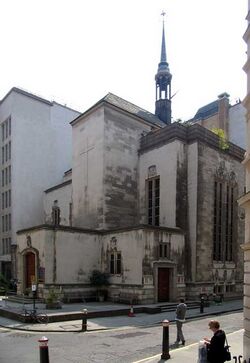Stranger churches
Topic: Social
 From HandWiki - Reading time: 3 min
From HandWiki - Reading time: 3 min
Strangers' church was a term used by English-speaking people for independent Protestant churches established in foreign lands or by foreigners in England during the Reformation. (The spelling stranger church is also found in texts of the period and modern scholarly works.)
English churches on the European continent
Many English churches sprang up in the Low Countries and Rhineland during the English Reformation. The most famous of these were established by the Marian exiles who fled Catholic persecution under Mary Tudor. Among these was the English Reformed Church, Amsterdam.
The Stranger Churches in England
The first Stranger Church to be set up in England was that led by the Italian reformer, Bernardino Ochino in 1547 (Cranmer's permission coming in January 1548). Although set up for the Italian community in London, it welcomed reformed Protestants of other nationalities as well. Cranmer made it quite clear that this was an example of how he wanted the reformation in England to proceed by forcing the traditionalist Bishop Edmund Bonner to attend Ochino's inaugural sermon. In 1550, there were three congregations - Dutch, French and Italian. To the dismay of bishop of London Nicholas Ridley, the fully independent congregations - from now known as one Stranger's Church received a royal charter and was incorporated by letters patent on 24 July 1550. The founder and first superintendent was Polish reformer John a Lasco. For the new community he wrote two fundamental writings - Confessio Londinensis, containing principles of faith, and Forma ac ratio, containing structure and rites.[1][2]
They received help of Protestant aristocrats such as William Cecil and Katherine Brandon, Duchess of Suffolk.[3]
The congregation received a grant of the Austin or Augustinian Friars Church which remains the site of the city's Dutch Protestant Church, the church itself having been destroyed in World War II. Upon incorporation, the church was renamed the "Temple of the Lord Jesus" and given four pastors: two for the Dutch church, and two for the French/Walloon church meeting in St. Anthony's Chapel.
Cranmer's main purposes in giving official sanction to the Churches seem to have been two-fold. Firstly, they provided a glimpse of how a reformed Protestant Church might work in England, within the episcopal system which many of the "hotter" reformers wished to abolish. Secondly, and perhaps more importantly, they helped Cranmer and his allies in the suppression of heretical strains of religion, such as the non-Trinitarian George van Parris.
Members of London's Dutch Stranger Church
- John a Lasco, first superintendent of the church
- Marten Micron, first pastor of the church
- Steven Mierdman, printer (pseud. Niclaes van Oldenborch), joined the church in 1550
- Justus Velsius, dissident, joined the church in 1563 until expelled from the kingdom
See also
- Marian exiles
- English Reformed Church, Amsterdam
- Dutch Church, Austin Friars
Further reading
- Hallowell Garrett, Christina (1938). The Marian exiles, a study in the origins of Elizabethan Puritanism. Cambridge University Press. ISBN 1-108-01126-8. OCLC 6812695. https://archive.org/details/marianexilesstud00garr.
- MacCulloch, Diarmaid, Thomas Cranmer (London, 1996)
- MacCulloch, Diarmaid, Tudor Church Militant: Edward VI and the Protestant Reformation (London, 1999)
- Pettegree, Andrew (1986). Foreign Protestant communities in sixteenth-century London. Oxford University Press. ISBN 0-19-822938-0. OCLC 13525196. https://archive.org/details/foreignprotestan0000pett.
- Spicer, Andrew (2012), "'A Place of Refuge and Sanctuary of a Holy Temple': Exile Communities and the Stranger Churches." In: Nigel Goose and Lien Luu (eds.), Immigrants in Tudor and Early Stuart England, Brighton: Sussex Academic Press, pp. 91–109.
- Spicer, Andrew, "The Consistory Records of Reformed Congregations and the Exile Churches." In: Proceedings of the Huguenot Society, 28 (2007), pp. 640–663.
- Kang, Min (2011), John a Lasco on Church Order: A Comparative Study with Special Attention to Church Offices
- Muylaert, Silke (2017), Reformation and Resistance: Authority and Order in England's Foreign Churches, 1550-1585
References
- ↑ Kang, Min (2011). John Calvin and John a Lasco on Church Order. p. 21-22,40..
- ↑ Muylaert, Silke (2017). Reformation and Resistance: Authority and Order in England's Foreign Churches, 1550-1585. pp. 36-37.
- ↑ A. Spicer, "'A Place of Refuge and Sanctuary of a Holy Temple': Exile Communities and the Stranger Churches." In: N. Goose and L. Luu (eds.), Immigrants in Tudor and Early Stuart England, Brighton: Sussex Academic Press, 2012, p. 93.
 |
 KSF
KSF
